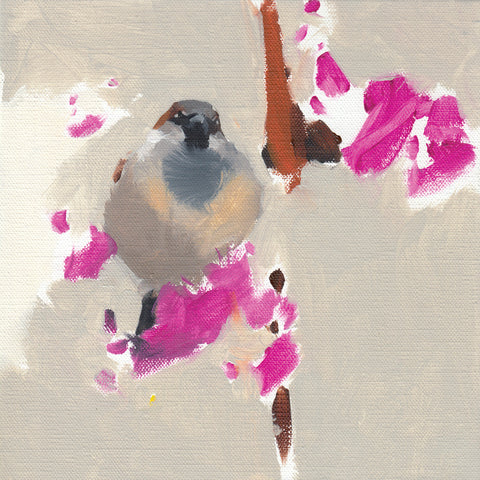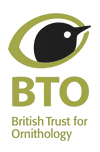
Celebrating World Sparrow Day 2023
For World Sparrow Day (20th March) we thought that we would share two of the contributions from our Into the Red publication, one featuring House Sparrow and the other Tree Sparrow. Both of these accounts were made possible thanks to the generosity of the writers and artists who contributed this wonderful material.
House Sparrow (Words Kate Bradbury, Art Esther Tyson)

The first time I saw a House Sparrow up close I was entranced. Who knew such a little brown bird had such intricate markings? I look at diagrams and read words like ‘nape’, mantle’ and ‘rump’ (parts of a bird’s body) and others like ‘lesser coverts’ ‘tertials’ and ‘primaries’ (types of feather). Both male and female House Sparrows look like they’re wearing the sharpest of tweed suits, the male with his perfect combination of warm orange-infused browns, plus black and grey, and the female a more subtle (some books would say dull) palette of creams and browns. Imagine putting a series of browns together and coming up with something so beautiful. You couldn’t do it. They’re a work of art, House Sparrows.
And yet, they’re still scruffy, which makes me love them even more. In my garden, they have an air of being a bit unwashed. Of having just got out of bed, they’re crumpled, somehow. There’s always a feather out of place, and their call – an almost constant “Cheep! Cheep! Cheep! Cheep!”, which I translate as “Hey! Hey! Hey! Hey!” – makes them seem as though they’re still a bit pissed from the night before. They have big parties in the soil (scientifically known as ‘dust bathing’), which makes them look so ridiculous that I laugh and laugh and laugh.
They seem to do alright, here, because the houses are old and full of holes, and most of the gardens are – at the moment – still intact. But I worry about them. They have been lost from so many city streets as, one by one, houses have been ‘done up’ and gardens – front and back – have been paved over, or covered with decking, fake grass or some other version of DEATH, like stones or purple slate chippings, to make them low maintenance and easy to rent out. A paved, fake-turfed or otherwise dead garden is no place for a House Sparrow. They’ll happily eat from your feeders but they need aphids and caterpillars to feed their young. And how many aphids and caterpillars did you last see on a pile of purple slate chippings?
They don’t need much: old and holey houses to make their nests, long grass and a few native plants to provide aphids and caterpillars, plus a nice big hedge to hang out in at night. “Hey! Hey! Hey! Hey!” says the hedge, every day, at dusk and dawn. “Hey! Hey! Hey! Hey!”
Hey House Sparrows. Please don’t go.
Tree Sparrow (Words Jamie Normington, Art Emma Price)

I live with a view like one I grew up with. It’s not the same, but it’ll do. A village edge view of hilly farmland, where wind and the sun have recently joined the local harvests. Moving back north taught us the name ‘Tree Sparrow’, one with a seemingly permanent caveat of “they’re in trouble” putting them on my list of dismissed things, that I’d probably never see.
Our rookie error of fastening a feeder to the bedroom window reminded us birds get up early and knock rather loudly. We stuck it where the sun doesn’t shine, giving us an alternative point of view to the less and less watched television. One evening we came home to a beautiful outline of dust on the window, above the little feeder. The shape of flight, of legs outstretched, wings high, the size of an honest newspaper’s front page. We didn’t have the camera trickery to photograph it. But I tried and showed a friend who said ‘Sparrowhawk’. And that’s where it all started to interest me.
I borrowed a too-heavy, overly-complicated book, and began perching by the window looking at the little lawn. That first day, I saw a crack team of birds working among the uncut grasses, finding food. The big black book had an illustration that not only matched the birds but also their exact behaviour, position and concentration. Tree Sparrows. I’m partly colour blind so have no idea what you might see, but they look very sharp in their matching uniforms and caps. I’ve only seen them fighting once, like a Tarantino movie on the cobbles, but that was in Yorkshire and things might be different there.
I’d always thought they were House Sparrows, as “Tree Sparrows were rare, weren’t they?” We quickly realised the dozens we half-saw daily were always Tree Sparrows, only ever been Tree Sparrows. Since then I watch them every day, see them learn to feed, flutter and fascinate. Someone who ‘knew about these things’ didn’t believe me, or my luck. The local bird club had never had any records for our ‘square’, never mind a record of a breeding and thriving population. They gave me a spreadsheet which I must confess I have never filled in. I don’t know why. Or what I’m waiting for. I’m still learning too.
But they’re in the right place, among people they can tolerate, and a landscape that changes slowly. Personally, I believe they are here because of a 77 year old woman who has spent half her weekly shopping money on bird food for longer than I’ve known her. They make her, me, the Sparrowhawks, the school’s hedges, and the village a very happy place to be indeed.
